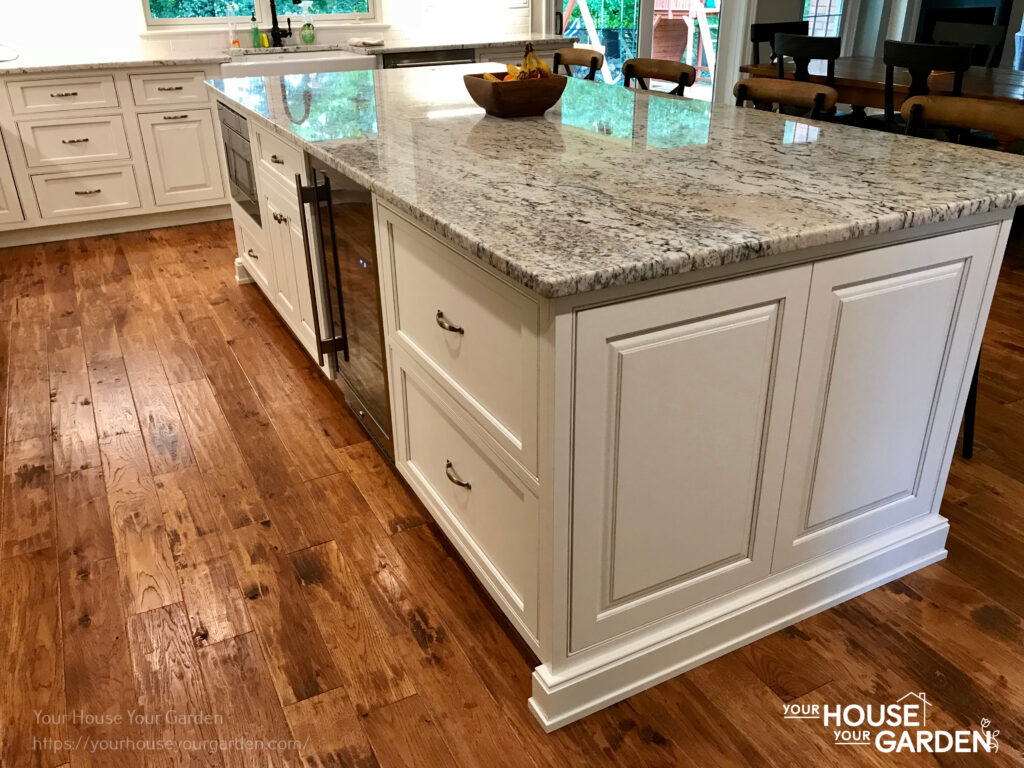Granite Countertops
Home » Home Remodeling » Kitchen Countertops » Granite Countertops

Choosing the right countertop for your indoor kitchen or outdoor area is an investment which is why it is such a big decision to make. When choosing between different countertop materials, granite might already be on your list. This particular material is attractive, versatile, and can complement different interiors. Choose a classic black or opt for a more neutral color. Whatever you are looking for, there is a granite counter for your home.


Reasons to Consider Granite Countertops
If you’re choosing between marble, soapstone, laminate, glass, or quartz countertops, here are some reasons you should look into a granite countertop instead. Granite countertops are:
Easy to Maintain
Compared to other countertop materials, granite is a popular choice for a busy kitchen. You will find granite countertops easy to maintain because they can withstand normal wear and tear. Easily clean up staining with household cleaners and wipe off dust and crumbs with a cloth to give your countertop a polished look.
Adds Value
High-end granite offers your home beauty and exudes luxury which can increase the value of your home. You may not know how much granite countertops can upgrade the feel and look of your bathroom or kitchen space but this is a great move if you are thinking of selling or renting out your home in the future.
Durable
This natural stone material for your counters is resistant to bacteria, moisture, heat, and stains when properly sealed. Known for their durability, new countertops made out of granite are not easy to scratch and stain which means that an installed countertop will last years and not harbor harmful bacteria.
Repairable
Granite counters are infinitely repairable when an accident happens or it has taken on extreme heat stress. Manufacturers or a maintenance company will typically offer a repair service for your countertop which can cost you from $35 to $85 for every hour. While granite countertops do not chip or scratch easily after installation. However, when it happens these can be repaired for $200 to $500. As for failing seams or big, noticeable cracks, expect prices to be around $700 for repairs.
Aesthetic
This natural stone is popular for a good reason. It is elegant, can spruce up any interior design style, adds beauty to a space, has different patterns, and is available in many colors. Choose between a granite slab that has hints of gold, pink, brown, and grey, or look for slabs that will complement your marble tiles, butcher block table, quartzite island, or glass tile backsplash.
Eco-friendly
Compared to other countertop materials, granite is a greener option. Granite is not made out of chemicals or other synthetic materials which means that it does not emit harmful gasses or radiation. Granite is also a natural stone that can last over 100 years which means that you will not have to continuously replace and purchase countertops.

How to Choose a Granite Countertop
When choosing granite countertops before a kitchen remodeling project, here are some factors to take into consideration:
Slab or Tile
Depending on your style, the size of your space, or your budget, you will have to choose the fabrication of this material. Granite slabs are great for a whole kitchen countertop but you may prefer tiles for the countertop of your sink in the bathroom.
Prices also vary between tile or slab but in general, tile will cost you less. Comparing the two, granite tiles will have visible grout lines which is why homeowners may choose to install a slab instead.
Grade
Picking out granite countertops for the kitchen means that you will have to determine the grade of granite you prefer and can afford. The grade of granite countertops can be determined by their color, veining patterns, thickness, soft materials mixed in, where they came from, pitting, and marking. You will have to choose from the following grades for this material:
Level 1: Builder’s grade, commercial grade, or entry-level granite is pre-fabricated and used for remodeling, furniture, and apartments. This is a lower quality option that is ⅜ inches thick and usually has a plywood backing for support. Low-grade granite is available in simple designs and standard colorways.
Level 2: This grade of granite has more design and color options as well as markings variety. Mid-grade granite is usually ¾ inches thick which makes it stronger than entry-level granite.
Level 3+: Granite with a grade of 3 or higher is made of the highest quality, has the rarest appearances and is more difficult to source. Granite slabs of this grade are at least ¾ inches thick and have the most unique colors, veining, patterns, and a combination of soft and hard materials per square foot.
Compare quotes between different manufacturers and take the grade of the granite into consideration for your kitchen countertop.
Color
Popular colors for your potential granite countertop include:
Alaska White: An Alaska white granite countertop is a blend of frosty white and pale silver or warm neutral hues running throughout the material.
Ubatuba: Ubatuba granite is a dark and finely textured stone. This slab is known for its black, grey, gold, and green speckles which are beautiful on countertops.
Silver Cloud: Spruce up your minimalist space with this variation of granite that features black, white, grey, and silver veining. For those looking for a more subtle greyscale for their countertops, this is the best color for you.
Absolute Black: Another popular option is this solid black granite. With its consistent color and texture, absolute black stone is great for both inside and outside of your home.
Black Galaxy: This type of granite is known for its medium-to fine grain and is favored for being mostly black with gold or white flecks.
Solarius: Use the Solarius slab in your kitchen if you are looking for yellow or gold granite. The brown and grey veins will match your rustic kitchen.
Crema Bordeaux: Another light colorway is crema Bordeaux which is a blend of orange, rust, pink, maroon, brown, and grey.
Blue Louise: To create a statement or make sure that your countertops are the focal point of your kitchen, this granite stone is a gorgeous blend of blue, green, red, brown, and yellow.
Butterfly Beige: Another neutral option, this is great if you want countertops that are beige but have flecks of cream, black, and white.
Picasso: similar to the art style, this grey granite has chunks of white, black, and grey.
Namibian Gold: With khaki and brown hues, this gold slab has grey veining and black flecks.
Finish
Like other countertop materials, granite is available in the following finishes:
Polished: This is the most common finish for countertops made out of granite because a countertop will have a shine that highlights the colors of the material.
Honed: Honed granite has a matte or a buffed satin look which is a more subdued choice perfect for busy areas.
Leathered: This finish will attract a customer because of its slightly glossy but textured appearance.
Flamed: For a home or business owner looking for a rustic and slightly imperfect option, granite with a flamed finish has bumps on the surface which add depth to every square foot of the material.
Bush Hammered: For a more weathered look, granite is struck until it has a textured surface. If you want a decorative option, this method will lighten granite and make it more porous.
Brushed: The surface of a slab is brushed until it has a porous texture. This is a popular finish choice for homeowners that want to bring out the different colors of the natural stone.
Caressed Granite: This finish has both shine and texture which suits those looking for a more rugged option that accentuates the natural colors of a slab.

FAQs on Granite Countertops
What are the problems with granite countertops?
Granite is typically low maintenance but will require sealing. This material can also be heavy which means that extra support may be needed. Additionally, some may find that the different colors, veining, and patterns per square foot of a slab are busy and overwhelming.
What is better: granite or quartz?
This depends on what you are looking for. Quartz countertops tend to be more durable and are more affordable than granite. On the other hand, granite countertops are more natural and more unique.
How long do granite countertops last?
Granite countertops can last a lifetime. This durable countertop option can last up to 100 years or more when properly maintained.
How much do granite countertops cost per square foot?
Per square foot, granite countertops can cost anywhere from $40 to $100.

